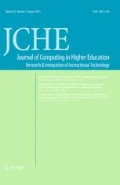Abstract
IN ANY COURSE IN INSTRUCTIONAL DESIGN, the design principles should not only be covered in the course content, but also demonstrated by the structure of the course itself. Telematics applications of various sorts can bring new dimensions into the instructional design of the course to better illustrate the subject matter. In this article we describe the design of a WWW-based course-support environment for a course in instructional design, given an overview of how the environment was used as part of the course experience, and summarize the student evaluation of the course. We call such an augmented learning process a “tele-learning” situation because telematics applications are involved. We conclude that such a course-support environment can extend the teaching and learning process, if well designed, by bringing added opportunities for communication and coaching, and by increasing student self-responsibility. We do not see such a tool as replacing the instructor, but enhancing instruction. The design of the environment should reflect this. Although the article describes a particular course on instructional design, we argue that the conclusions can be valid for a variety of disciplines and instructional approaches.
Similar content being viewed by others
References
Collis, B., & De Boer, W. (1998). The TeleTOP Decision Support Tool (DST). In J. van den Akker, N. Nieveen, & Tj. Plomp (Eds.),Design methodology and development research in education and training, (in press).Dordrecht:Kluwer Academic Publishers.
Collis, B., Knezek, G., Lai, K.W., Pelgrum, H., Plomp, T.J., & Sakamoto, T. (Eds.). (1996).Children and computers in school.Mahwah, NJ:Lawrence Erlbaum Associates, Publishers.
Dijkstra, S., Seel, N., Schott, F. & Tennyson, R.D. (Eds). (1997).Instructional Design: International Perspectives, (Vol. 2).Mahwah, NJ:Lawrence Erlbaum Associates, Publishers.
Gustafson, K.L., & Branch, R.M. (1997).Survey of instructional design models. (3rd ed.)Syracuse, NY:ERIC Clearinghouse on Information & Technology, Syracuse University.
Sfard, A. (1998). On two metaphors for learning and the dangers of choosing just one.Educational Researcher,27(2), 4–13.
Tennyson, R.D., Schott, F., Seel, N., & Dijkstra, S. (Eds). (1997).Instructional Design: International Perspectives, (Vol. 1). Mahwah, NJ: Lawrence Erlbaum Associates, Publishers.
Author information
Authors and Affiliations
Additional information
ABOUT THE AUTHORS
Professor Dr. Sanne Dijkstra is Professor of Instructional Technology in the Faculty of Educational Science and Technology at the University of Twente and serves as Chair of the Graduate School of Teacher Education. His areas of interest include industrial and educational psychology. Much of his research publications are on instructional design and the effectiveness and efficiency of the models used. He has a strong interest in the acquisition of knowledge and skills by solving problems.
Professor Dr. Betty Collis is Professor of Tele-Learning in the Faculty of Educational Science and Technology at the University of Twente, and also Senior Researcher for Telematics Learning Technology in the multidisciplinary Centre for Telematics and Information Technology at the same university. She has been designing and using WWW-based support environments with her courses since 1994 and has published widely about the design and impact of such environments (see http://www.edte.utwente.nl/user/ism/Collis/home.htm). She is the chair of the TeleTOP Project in the Faculty of Educational Science and Technology.
Deniz Eseryel, at the time of writing this article, was a student in the Masters Programme in Educational and Training Systems Design and completed her thesis based on her participation in the design and development of the Instructional Design Theories course. She will soon be beginning Ph.D. work in the area, with Professors Dijkstra and Collis.
Rights and permissions
About this article
Cite this article
Dijkstra, S., Collis, B. & Eseryel, D. Instructional design for tele-learning. J. Comput. High. Educ. 10, 3–18 (1999). https://doi.org/10.1007/BF02948720
Issue Date:
DOI: https://doi.org/10.1007/BF02948720




